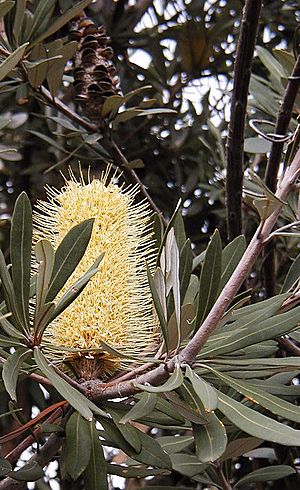Banksia subg. Spathulatae facts for kids
Quick facts for kids Banksia subg. Spathulatae |
|
|---|---|
 |
|
| B. integrifolia (coast banksia), a well-known plant in this group. | |
| Scientific classification |
|
| Kingdom: | Plantae |
| Clade: | Tracheophytes |
| Clade: | Angiosperms |
| Clade: | Eudicots |
| Order: | Proteales |
| Family: | Proteaceae |
| Genus: | Banksia |
| Subgenus: | Banksia subg. Spathulatae A.R.Mast & K.R.Thiele |
Banksia subg. Spathulatae is a special scientific name for a group of plants within the larger Banksia genus. Think of a subgenus as a smaller family within a bigger plant family. This name was officially created in 2007 by two scientists, Austin Mast and Kevin Thiele. They grouped these plants together because they all share a unique feature: their first leaves, called cotyledons, are shaped like tiny spoons.
Scientists decided to create this new group after studying the DNA of Banksia plants. Their research showed that some Banksia species were more closely related to plants from another genus called Dryandra than to other Banksia plants. To make the plant family tree more accurate, they decided to combine Dryandra into Banksia. This new subgenus helps organize these plants based on their shared characteristics and genetic links.
Contents
What is Banksia subg. Spathulatae?
This subgenus includes all the Banksia plants that have special spoon-shaped first leaves. These leaves are the very first ones that appear when a plant sprouts from a seed. The name "spathulate" comes from the word "spatula," which means spoon-shaped.
Key Features of This Group
Plants in Banksia subg. Spathulatae have a few important features:
- Spoon-shaped cotyledons: Their first leaves are distinctly spoon-shaped.
- Unbeaked seed pods: The seed pods, also called follicles, do not have a pointed "beak" at the end.
- Sunken stomata: They have tiny pores on their leaves, called stomates, that are slightly sunken with narrow openings. This helps them save water.
The B. integrifolia (coast banksia) is a great example of a plant found in this subgenus. It's a common and well-known species that shows these features.
How Scientists Group Plants
Scientists use many methods to understand how plants are related and to group them. For a long time, they mainly looked at physical features like leaf shape, flower structure, and seed pods. However, with new technology, they can now study the DNA of plants.
The Role of DNA in Plant Classification
Studying DNA is like looking at a plant's genetic blueprint. By comparing the DNA sequences of different plants, scientists can see how closely related they are. This method often reveals relationships that aren't obvious just by looking at the plants.
In the case of Banksia and Dryandra, DNA analysis showed that these two groups were very closely linked. Some Banksia plants were actually more related to Dryandra plants than to other Banksia plants. This discovery led scientists Austin Mast and Kevin Thiele to propose a new way of organizing these plants.
Why the Change in 2007?
Before 2007, Banksia and Dryandra were considered separate groups. But the DNA evidence was very strong. To make the scientific classification more accurate and reflect the true evolutionary history of these plants, Mast and Thiele decided to:
- Move all Dryandra species into the Banksia genus. This means Dryandra is now part of Banksia.
- Create Banksia subg. Spathulatae for all the species that have those special spoon-shaped first leaves and other shared traits.
This change helps scientists and plant enthusiasts better understand the diversity and relationships within the amazing Banksia family. Scientists are still working on a complete new arrangement as they gather more DNA information from all the Dryandra species.

